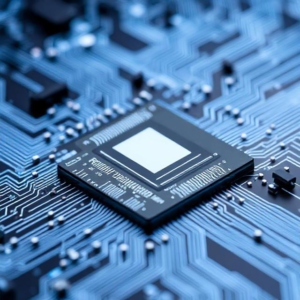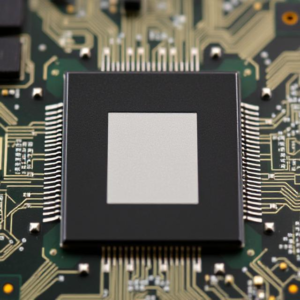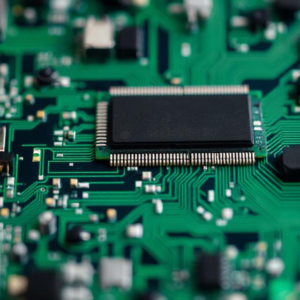What is ASIC?
ASIC stands for Application-Specific Integrated Circuit. It is a type of integrated circuit (IC) designed and built for a specific purpose or application. Unlike general-purpose chips (like microprocessors or memory chips), which are designed to perform a wide range of tasks, an ASIC is created to do one specific task or a narrow range of related tasks very efficiently.

Key Features of ASIC:
- Custom Design: An ASIC is designed to meet the exact requirements of a particular application. This makes it more efficient than general-purpose chips.
- High Performance: Because it’s made for a specific task, it can perform that task much faster and more efficiently than general-purpose chips.
- Low Power Consumption: Since the chip is optimized for one function, it can consume less power compared to other general-purpose circuits.
- Small Size: ASICs are usually smaller and more compact because they’re designed specifically for a task, so they don’t include unnecessary components.
How Does ASIC Design Work?
Designing an ASIC is a complex process that involves several steps. Here’s a simplified breakdown of how an ASIC is designed:
- Define the Requirements:
- The first step in ASIC design is to clearly define what the chip needs to do. For example, it could be a chip that controls a microwave oven, handles encryption for secure communications, or processes signals in a car’s safety system.
- Create a Specification:
- After defining the requirements, engineers create a specification document that details exactly how the chip should behave. This includes the functions it needs to perform, the input and output signals, power consumption requirements, speed, and more.
- Design the Architecture:
- Engineers then create the architecture of the ASIC. This is the blueprint of how the chip will be organized and how different parts of the chip will interact.
- For example, they decide how to arrange components like logic gates, registers, and buses on the chip.
- Logic Design and Simulation:
- In this step, engineers design the logic circuits that perform the chip’s tasks. They use programming languages like VHDL or Verilog to describe the behavior of the chip.
- Once the logic is defined, the design is simulated to check if it works correctly. Simulations allow engineers to test and verify the design before moving to the next steps.
- Physical Design and Layout:
- Once the logic design is verified, the physical design begins. This involves translating the logical design into a physical layout that can be fabricated on a silicon chip.
- Engineers create a detailed layout showing where each circuit element will be placed on the chip and how the components will be connected.
- Fabrication:
- After finalizing the layout, the design is sent to a foundry (a company that manufactures the chips) where the chip is physically produced. This process involves a series of complex steps to etch the design onto a silicon wafer.
- Testing and Validation:
- Once the ASIC is fabricated, it undergoes extensive testing to ensure that it works as expected. Any issues found during testing might require changes and another round of fabrication.
Types of ASICs:
- Full-Custom ASIC:
- In a full-custom ASIC, every aspect of the design is customized, including the logic gates and interconnections. This results in the highest performance and the smallest size but takes the longest time to design and is the most expensive.
- Semi-Custom ASIC:
- A semi-custom ASIC uses predefined building blocks (called IP cores) that can be combined in various ways to create the chip. This approach speeds up the design process and reduces costs, but the chip may not be as optimized as a full-custom design.
- Programmable ASIC:
- Programmable ASICs (also known as FPGA-based ASICs) allow for some degree of reprogramming even after fabrication. These are flexible and can be reconfigured, but they might not be as efficient as full-custom ASICs.
Applications of ASICs:
ASICs are used in many specialized fields and applications. Here are some common examples:
- Consumer Electronics:
- ASICs are used in devices like smartphones, tablets, and gaming consoles to perform specific tasks like processing graphics, handling wireless communication, or controlling input devices.
- Cryptocurrency Mining:
- In the world of cryptocurrency mining, ASIC miners are used to perform the complex calculations needed to mine coins like Bitcoin. These ASICs are highly optimized to solve the cryptographic puzzles used in mining much faster and more efficiently than general-purpose hardware.
- Network Equipment:
- ASICs are used in networking equipment like routers, switches, and firewalls to accelerate data processing and ensure that data is transmitted quickly and securely.
- Automotive Industry:
- In cars, ASICs are used in various safety systems like airbag control, anti-lock braking systems (ABS), and infotainment systems to provide reliable and fast performance.
- Medical Devices:
- ASICs are used in medical devices like pacemakers or hearing aids, where reliability and power efficiency are critical.
- Telecommunications:
- In telecom systems, ASICs are used to handle tasks such as signal processing, modulation, and demodulation, helping to improve the speed and quality of communication networks.
- Signal Processing:
- ASICs are commonly used in applications that require digital signal processing (DSP), such as audio processing, video encoding, or image processing.
Advantages of ASICs:
- High Performance: ASICs are optimized for specific tasks, so they can perform those tasks much faster than general-purpose processors.
- Low Power Consumption: Because ASICs are designed for a specific purpose, they can consume less power, which is important in mobile devices and other power-sensitive applications.
- Small Size: ASICs can be compact and integrated into small devices, which is useful in applications like wearable tech or medical implants.
- Cost Efficiency in Large Quantities: Once the design is complete, ASICs can be mass-produced at a relatively low cost, especially if they are made in large volumes.
Disadvantages of ASICs:
- High Initial Cost: Designing and fabricating an ASIC is expensive, especially for custom designs. This makes them less attractive for low-volume products.
- Time-Consuming: The design and manufacturing process for ASICs can take a long time, especially for complex designs.
- Lack of Flexibility: Once an ASIC is designed and fabricated, it cannot be changed. If a design mistake is made or if there is a need for modification, the process has to be repeated, which can be costly.
Summary:
- ASIC (Application-Specific Integrated Circuit) is a custom-designed chip that is built to perform a specific task or function.
- The process of designing an ASIC involves defining requirements, creating a specification, designing logic, simulating, and then physically laying out and fabricating the chip.
- ASICs are widely used in consumer electronics, cryptocurrency mining, networking, automotive systems, and more.
- Advantages include high performance, low power, small size, and cost efficiency in large volumes, while disadvantages include high initial costs and lack of flexibility.
In simple terms, think of an ASIC as a special-purpose “tool” built to do a job much better and faster than a general-purpose “tool” (like a regular processor). However, it’s expensive and time-consuming to create, and once it’s made, you can’t change its design.











